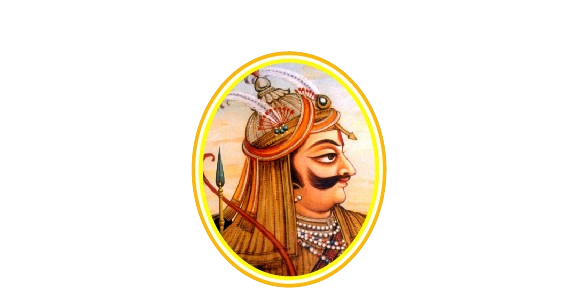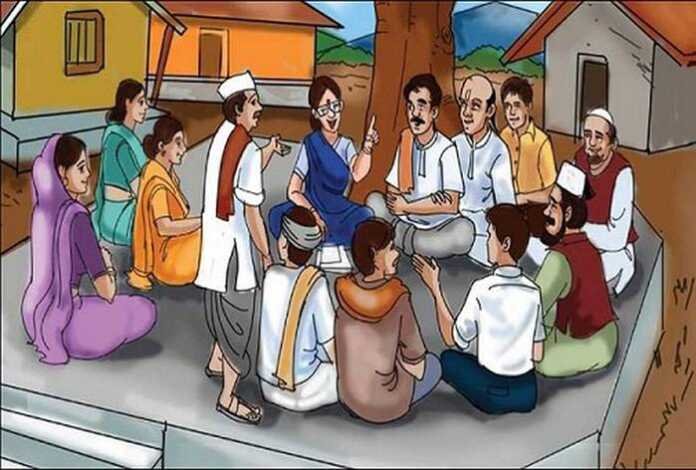Administrative Institutions Of Mewar In The Pre-Mughal Times were based on Rajanya system of Aryan Janas of Rgvedik period and on the Aryan society of Pouranik period.
The old Indian political system was founded on the identity of the clan with the land. The head of the clan was the ruler of the land and the chief of his own clan. European historians like Maxmuller and Col. Tod tried to establish that the social structure of the Rajput society arose out of circumstances similar to those that gave birth to feudalism in Europe, But this was not true.
Social structure of the the Rajput society was similar to Rajanya of Aryan Janas of Rgvedik period and more of it, similar to the Aryan society of Pouranik period.
Rajput Monarchy tried to live up to the ideals enshrined in the Dharmasastras and the ancient Indian works on polity. Generally the rulers sought to promote the material moral welfare of their subjects. Monarchy on the whole was benevolent and not oppressive.[1]
Ordinarily succession to the throne was governed by the law of primogeniture. However it could be set aside if the interests of the State so demanded. Before accession to the throne the prince was required to give evidence of his fitness and valour in the Tika-Daur, a sort of hunting expedition or a raid.[2]
If the elder son was physically disabled, his younger brother would act as an heir-apparent.[3] On failure of natural heirs a Rajput king could adopt a successor from other clan.[4] Dowager queens assumed the reigns of government during the minority of their reigning sons.[5]
The king was assisted in administration by a number of high officials. The Ahara Varaha Temple Inscription of the 10th century A.D. mentions several officials, viz., the king, the heir-apparent, amatya (chief minister), Sandhi Vigrahika, the minister in-charge of war and peace, akshapatalika theAccountant), Bandipati (the genealogist) and Bhisagacharya (the physician).[6]
Pradhan Amatya
The office of the Mahamatya or Pradhan is mentioned in the inscriptions of Rana Kumbha and Sanga.[7] A Jain work named Sravakpratikra manasutra Churni of the 13th century mentions Mahamatya of Rawal Tej Singh.
Srikaran or keeper of the royal seal was another official.[8] The treasurer of Maharana Kumbha was called Bhandari, which was a term derived from Bhandagarika of the earlier days. Talaraksha was the police officer like Kotwal of the Mughal times.[9]
Mahajana Sabha
The people enjoyed considerable powers in the sphere of local government. There existed an important local assembly called the Mahajana Sabha in all the important towns of Mewar. Kanhadde-Prabandha, a contemporary literary work refers to it’s widespread existence in the state. This assembly enjoyed wide powers and the rulers normally respected its representative character. The oldest mention of this assembly occurs in an inscription of Siladitya dated the Vikram Samvat 703.A military official of the state named Yasodeva Baladhip is stated to have been honoured by the King and the Mahajan Sabha alike.[10]
The consent of this local assembly was required for levying new taxes.[11] Mahajana Sabha probably also had a power to grant lands. It could discuss not only local affairs but also state policies.[12]
Panchakula
The Panchakula which was the prototype of the present Panchayat is an old institution of local government. It had a definite place in the Pratihar and post-Pratihar administration. This body seems to have been the executive organ of the Mahajan Sabha. Unlike modern Panchayata, Panchakula was not an elective body. The Bhinmal Inscriptions dated Vikram Samvat 1306 and 1336 refer to the appointment of its members by the King. The Panchakula enjoyed wide powers and also performed judicial functions.[13]
We find references to a joint-sitting of the Karanikas and the panchakulas for the purpose of judicial investigation. The Karnikas represented the official and the punchakula the popular element. The panchakulas represented the mahajana and were also sometimes called Mahajana. A reference to a mahajana-Krtadanda i.e. ‘a punishment awarded by the mahajana’ occurs in the Brhatkathakosa.[14]
The Samaraichchakaha, a work written by Haribhadra Suri, states that for investigating a charge of theft, the Karnikas accompanied the nagar-mahantakas (elders of the town).
It is further stated that the Karnikas were supervised and controlled by the chief elders of the town. [15]
Here panchakulas are referred to by the name of Nagar-mahantakas. The Samaraichchakaha states that the town assembly deputed, for the purpose of investigation, four of its representatives who were proficient in Dharma and Artha, old in age, well established in dharma and highly respected byAll citizens.[16]
Thus it is evident that the panchakula was associated with the administration of justice. From the Mahaprajaya-Nataka, we learn that the panchakula could also appropriate to itself the property of one dying without an heir. Sometimes the panchakula, along with the Gosthis, would also look after the management of the temples.[17] The inscriptions found in Gujrat and the Lekhapaddhatis also tell us about other powers of the panchakula.
The panchakulas also granted certificates of sale and concessions to traders, farmed out villages, collected the state revenue, registered the grants and arbitrated between disputing parties.[18]
Mandapika
Mandapika was another important civic institution. The Siyodani inscription refers to a panchakula in-charge of the mandapika. The main function of Mandapika was the collection of the cess at the rate fixed by the Government. Mandapikas probably functioned in all the principal towns of Mewar. The inscriptions refer to their existence in the towns like Chittor, Sajjanpur, Delwara etc.
These were in the nature of custom houses for collecting tolls on the frontiers or at the town gates. The kings would often give donations directly from the amounts received from the Mandapikas.[19] The Mandapikas also looked to the disbursement of the dues collected by them.[20]
Thus we see that the Administrative Institutions Of Mewar In The Pre-Mughal Times were similer to Pouranik period of Aryan society.
REFERENCES
[1] Akshya Niti-Sudhakar, pp. 15-50.
[2] Hamir’s accession illustrates the point. Tod has also referred to the Tika Daurrites.
[3] Sakti Kumar’s son Amba Prasnd was succeeded by his younger brother.
[4] Kumbhalgarh Prasasti verses 143-44 refer to prince Vairat’s adoption from among allatt’s descendants.
[5] The instances of Mahalaxshmi, Raja Allatt’s mother and Hansa Bai. Mokal’s mother can be cited in this connection.
[6] Dr. R.G. Sharma, Administrative Institutions Of Mewar In The Pre_Mughal Times, Rajasthan History Congress Proceedings, pp. 44-47.
[7] Chirava Insription published in Vienna Oriental Journal vol. XXI, pp. 155-62.
[8] Nadesama Insription dated V. S. 1279; also a Jain work Pakshivriti.
[9] Chirava Inscription dated 1236A. D., see for Part III, p. 21.
[10] Godwad Inscription dated Vikram Samvat 1172.
[11] Juna Inscription of Vikram Samvat 1352 and Nadol Inscription of Vikram Samvat 1200.
[12] Dasharatha Sharma, Early Chauhan Dynasties, pp. 200-2.
[13] Samaraditya Katha, p. 270; also Brihat katha kosa, Katha No. 121.
[14] Katha 30, Verses 18-19.
[15] Dr. R.G. Sharma, Administrative Institutions Of Mewar In The Pre_Mughal Times, Rajasthan History Congress Proceedings, pp. 44-47.
[16] Ghatiyala Inserption.
[17] Samantsingh’s Inscription of Ratnapur dated V. S. 1348.
[18] Samaraichchakaha, p. 497.
[19] Dasharatha Sharma, Rajasthan through the Ages, p. 61.
[20] Nadol Inscription dated V. S. 1195 asoj vadi 15; Inscription of Kareda Jain temple of V. S. 1326.




